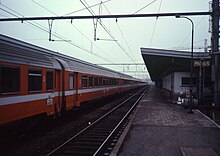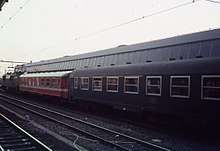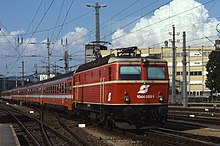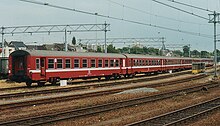Eurofima C1 paintwork

The Eurofima C1 paint scheme was a project started in the 1970s for a uniform design for passenger coaches in international express train traffic in Western Europe.
design
According to the specifications of the European Society for the Financing of Railway Material (Eurofima), the car body should be kept in a pure orange ( RAL 2004) signal color in keeping with the zeitgeist of the time . There was also a 250 millimeter wide, circumferential contrasting or decorative strip in light gray (RAL 7035) below the ribbon window and, if necessary, an additional yellow stripe under the roof edge to identify the first class of car , in France also with a green stripe for the second class. Owner labels , class numbers, car numbers and other technical labels were white, while umbra gray (RAL 7022) was provided for the roof and the aprons . The transitional front doors were again pure orange, but without additional contrasting stripes .
While the colors were the same for all participating railways, each company followed its own standards in the arrangement and font of the lettering. In addition, the Italian state railway originally relied on attached class numbers made of aluminum, later they used yellow class numbers - similar to Belgium. The Swiss Federal Railways, in turn, only used yellow numbers for the first class of car. In Switzerland, were also grab handles partially yellow and the roof ends in certain types of cars instead umbra also pure orange.
history
Eurofima wagons
Already for the vehicles used in the high-quality Trans-Europ-Express (TEE), this type of train operated from 1957, the initially seven state railways involved in Belgium , Germany , France , Italy , Luxembourg , the Netherlands and Switzerland agreed on a transnational one Standard paintwork in red / cream. Another transnational standard design then existed from 1971 for the TEN sleeping car pool , whose cars were cobalt blue.
When in the first half of the 1970s it was time to order the 510 Eurofima wagons , which were largely identical , five European railway administrations decided again - including the National Society of the Belgian Railways (NMBS / SNCB), the French Société Nationale des Chemins de fer Français ( SNCF), the Italian Ferrovie dello Stato Italiane (FS), the Austrian Federal Railways (ÖBB) and the Swiss Federal Railways (SBB) - to introduce a third European standard paint scheme.
On March 25, 1975, refer to the decided Directors-General of the State Railways involved personally in a joint meeting in favor of the design that the three Italian as early as 1973 pre-produced Eurofima prototypes of the genre had ABz. The German Federal Railroad (DB), which had also only just had an unsuccessful color attempt with the pop paint scheme , was not convinced by the new concept. An alternative design presented by her in 1974 with identically arranged contrasting stripes but Olympic blue (RAL 5012) instead of pure orange basic color remained without any response. Furthermore, the SNCF only painted the few wagons intended for Benelux traffic in accordance with the Eurofima C1 specification, so ultimately only 311 of the total of 510 wagons received the new design:
| society | number |
|---|---|
| FS | 103 pieces |
| ÖBB | 100 pieces |
| NMBS / SNCB | 80 pieces |
| SBB | 20 piece |
| SNCF | 8 of a total of 100, relating to the first cars with the numbers 61 87 19 70 900 to 907 |
In the case of the Eurofima cars, the C1 design also corresponded to the interior design. The seats in the first class were originally red, those in the second class were orange-brown, the partition walls were light beige and the lower areas of the corridor walls and compartment doors were blue in the first class and light gray in the second class, while the entry areas were again entirely in pure orange .
Other cars delivered in pure orange-light gray

In addition to the joint order, the five above-mentioned railway companies painted a total of 604 other RIC -capable vehicles for international traffic that were procured in those years in pure orange-light gray. Overall, the number of pure orange-light gray non-Eurofima cars significantly exceeded the number of their role models. While with the above Eurofima wagon exclusively air-conditioned compartment car acted, were among the other cars - partly unklimatisierte - open plan , dining , baggage and half baggage car, in Austria additionally car coaches . However, due to the design, the latter did not have a light gray contrasting stripe.
| society | dare |
|---|---|
| FS | 10 of a total of 93 Dz baggage cars ( tipo 1975 , built 1975–1982, first delivered in pure orange-light gray 1977) |
| ÖBB | 174 UIC-Z1 cars (105 Bmz, 45 ABmz, 15 Amz and 10 WRmz, built 1976–1982), 130 UIC-Z2 cars (105 Bmz, 15 Dmsz and 10 BDmsz, built 1980–1982), 40 DDm- 98-70 motorail coaches (built 1982-1986) |
| NMBS / SNCB | 89 I10 cars (74 B11t and 15 A11t, built 1987–1988), 34 Dms baggage cars |
| SBB | 40 Bm 51 compartment cars (built 1977, doors unpainted), 30 Bpm 61 open seating cars of the UIC type Z1 (built from 1980) |
| SNCF | 35 of a total of 220 Corail large -capacity cars of the type B 10 tu, 11 of a total of 120 Corail compartment / luggage cars of the type B 6 Dd2 (roller doors unpainted), 10 of a total of 75 Corail compartment cars of the type A 4 B 6 and the like |
Repainted old wagons
Furthermore, three of the railway administrations involved also repainted individual RIC-capable old wagons in pure orange-light gray, including wagons from the interwar period. While all of the cars mentioned in the previous section had the UIC standard length of 26.4 meters, the 223 repainted cars also included shorter vehicles, including saloon cars in Austria :
| society | dare |
|---|---|
| ÖBB | 60 UIC-X passenger cars (43 B and 17 AB, built 1962–1964), 34 SGP passenger cars ( 19 AB and 15 A, built 1951–1953), 30 SGP passenger cars (20 B and 10 A, built 1957– 1959), 10 SGP baggage cars of type D4eüh (built 1961), 10 DDm 98-80 motorail coaches (built 1971), 6 Spanten baggage cars of type Ds 95-80.4, 1 SGP prototype of type Amoz (built 1971), 1 type SRmz 89-80.6 comfort car (built 1970, repainted 1980), 1 saloon car (Salon 10, built 1966), 1 skirted car (Salon 11, built 1940) |
| NMBS / SNCB | 40 I4 cars (20 AB, 19 A and 1 B, built 1966–1967), 12 I2-AR buffet cars with first-class compartments (built 1952), 5 dining cars (built 1955 near Breda based on damaged cars from 1926 –1929), rented from CIWL , 2 dining cars (built in 1927 near Reggiane ), rented from CIWL |
| SBB | 10 WRm 61 dining cars (built 1967, doors unpainted) |
Conclusion
Ultimately, the project was not able to prevail across the board. The total of 1138 orange-light gray cars were sufficient for this
- 599 in Austria
- 262 in Belgium
- 113 in Italy
- 100 in Switzerland
- 64 in France
Far from over - especially since they were never all in operation in this form at the same time. Mixed-colored passenger trains therefore remained the order of the day in international traffic, while pure-bred trains in C1 paintwork remained the exception. This effect was reinforced by the then widespread coaches , apart from missing in accordance painted sleeping car , couchette , Bahnpostwagen and locomotives . Only the Austrian Federal Railways have been using blood orange as the standard paintwork for locomotives since the late 1960s , so that at least in Austria - where the C1 paintwork was also the standard paintwork for high-quality express trains (Ex) in Germany at times - a reasonably uniform appearance of the day trains is guaranteed was. In addition, the Belgian State Railways created a dark red domestic paint scheme at the time, in which the contrasting stripes were executed exactly analogous to the C1 design and served as a connecting design element in mixed trains.
At the latest with the introduction of the TEE successor EuroCity in 1987 , the European state railways finally relied on individual designs again. The first thing that happened was the SNCF, which in any case had the fewest cars in pure orange-light gray, said goodbye to the C1 design in the early 1980s and repainted its representatives in the regular Corail colors by 1987. In March 1987, the ÖBB presented their new long-distance transport color concept umbra gray-traffic red , whereupon the last C1-painted passenger coach disappeared from the scene in 1996. In Italy the last pure orange-light gray car ran until at least December 2000, in Switzerland the design could be found until 2003. In Belgium, on the other hand, the Eurofima C1 paintwork was even able to last up to 2008 in individual cases, so it existed for 35 years in total.
Independently of Eurofima, the Association of Swiss Transport Companies (VST), to which the Swiss Federal Railways were not yet a member at the time, also propagated the same color scheme for its member companies from 1974 . However, this so-called VST standard paintwork was also unable to establish itself. In contrast, Italy successfully introduced a nationwide orange uniform paint scheme for all public urban transport in 1977, albeit without contrasting stripes.
Web links
- FS e Trenitalia livery: C1 (Eurofima) , overview on scalaenne.wordpress.com, accessed on 22 August 2017
- The ÖBB Eurofimawagen from LSModels on modellbahninfo.org, accessed on August 25, 2017









